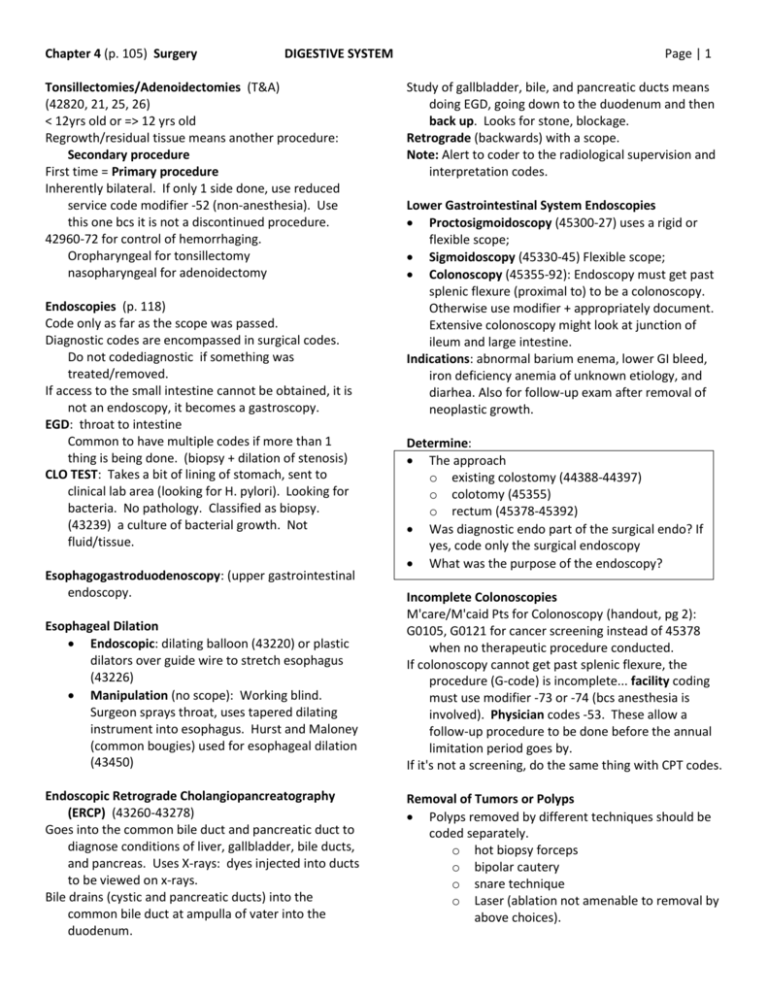Chapter 4 (p. 105) Surgery DIGESTIVE SYSTEM Page
advertisement

Chapter 4 (p. 105) Surgery DIGESTIVE SYSTEM Tonsillectomies/Adenoidectomies (T&A) (42820, 21, 25, 26) < 12yrs old or => 12 yrs old Regrowth/residual tissue means another procedure: Secondary procedure First time = Primary procedure Inherently bilateral. If only 1 side done, use reduced service code modifier -52 (non-anesthesia). Use this one bcs it is not a discontinued procedure. 42960-72 for control of hemorrhaging. Oropharyngeal for tonsillectomy nasopharyngeal for adenoidectomy Endoscopies (p. 118) Code only as far as the scope was passed. Diagnostic codes are encompassed in surgical codes. Do not codediagnostic if something was treated/removed. If access to the small intestine cannot be obtained, it is not an endoscopy, it becomes a gastroscopy. EGD: throat to intestine Common to have multiple codes if more than 1 thing is being done. (biopsy + dilation of stenosis) CLO TEST: Takes a bit of lining of stomach, sent to clinical lab area (looking for H. pylori). Looking for bacteria. No pathology. Classified as biopsy. (43239) a culture of bacterial growth. Not fluid/tissue. Esophagogastroduodenoscopy: (upper gastrointestinal endoscopy. Esophageal Dilation Endoscopic: dilating balloon (43220) or plastic dilators over guide wire to stretch esophagus (43226) Manipulation (no scope): Working blind. Surgeon sprays throat, uses tapered dilating instrument into esophagus. Hurst and Maloney (common bougies) used for esophageal dilation (43450) Endoscopic Retrograde Cholangiopancreatography (ERCP) (43260-43278) Goes into the common bile duct and pancreatic duct to diagnose conditions of liver, gallbladder, bile ducts, and pancreas. Uses X-rays: dyes injected into ducts to be viewed on x-rays. Bile drains (cystic and pancreatic ducts) into the common bile duct at ampulla of vater into the duodenum. Page | 1 Study of gallbladder, bile, and pancreatic ducts means doing EGD, going down to the duodenum and then back up. Looks for stone, blockage. Retrograde (backwards) with a scope. Note: Alert to coder to the radiological supervision and interpretation codes. Lower Gastrointestinal System Endoscopies Proctosigmoidoscopy (45300-27) uses a rigid or flexible scope; Sigmoidoscopy (45330-45) Flexible scope; Colonoscopy (45355-92): Endoscopy must get past splenic flexure (proximal to) to be a colonoscopy. Otherwise use modifier + appropriately document. Extensive colonoscopy might look at junction of ileum and large intestine. Indications: abnormal barium enema, lower GI bleed, iron deficiency anemia of unknown etiology, and diarhea. Also for follow-up exam after removal of neoplastic growth. Determine: The approach o existing colostomy (44388-44397) o colotomy (45355) o rectum (45378-45392) Was diagnostic endo part of the surgical endo? If yes, code only the surgical endoscopy What was the purpose of the endoscopy? Incomplete Colonoscopies M'care/M'caid Pts for Colonoscopy (handout, pg 2): G0105, G0121 for cancer screening instead of 45378 when no therapeutic procedure conducted. If colonoscopy cannot get past splenic flexure, the procedure (G-code) is incomplete... facility coding must use modifier -73 or -74 (bcs anesthesia is involved). Physician codes -53. These allow a follow-up procedure to be done before the annual limitation period goes by. If it's not a screening, do the same thing with CPT codes. Removal of Tumors or Polyps Polyps removed by different techniques should be coded separately. o hot biopsy forceps o bipolar cautery o snare technique o Laser (ablation not amenable to removal by above choices). Chapter 4 (p. 105) Surgery DIGESTIVE SYSTEM Biopsy and Lesion Removal Lesion removal may be performed after a biopsy or without a biopsy. Guidelines: Biopsy of lesion + excision of the same lesion in same operative episode, code the excision only One lesion biopsied and a different lesion excised, assign a code for the biopsy and a code for the exicision. Biopsy code gets -59 appended. Use only one code if “with or without biopsy” in narrative. Biopsy codes using “with biopsy, single or multiple” are used only once, regarless of the number of biopsies taken. Incision of External Thrombosed Hemorrhoid (46083) Clot and diseased hemorrhoid plexus are removed in one piece. Rubber Band Ligation (46221) Without incision or excision. Rubber bands at base ligate and cut off circulation till they slough off. Destruction of Internal Hemorrhoids by Thermal Energy (46930) Cautery, radiofrequency, and infrared coagulation (light source coagulates the veins above the hemorrhoid, causing it to shrink and recede. Suture Ligation (46945-46946) Ties base of hemorrhoid with suture material. Documentation must support the number of columns or groups ligated. Hemorrhoidectomy (46250-46262) Excision codes differentiated by internal, external, or both. Need documentation to indicate number of columns or groups (single vs. multiple) Destruction by Cryosurgery (46999) Use unlisted code. Hernia Repairs Coded by the type and/or site of the hernia the history of the hernia the age of the pt clinical presentation of the hernia Page | 2 Traditional Hernia Repair (49491-49611) 3 types of repairs: 1. Conventional: Physician pushes bulging tissue back into abd. cavity, stitches it up. 4-6 wk recovery. 2. Use of Mesh (49568) Mesh is only coded for incisional or ventral hernia repairs. This is an add-on code. Mesh is not coded on other hernia repairs where it is used. 3. Laparoscopic Hernia Repair (49650-49659) Commonly used to repair bilateral and recurrent hernias. Surgical Laparoscopy includes diagnostic laparoscopy. Paresophageal Hiatal Hernia Repair (43332-43337) The stomach pushes through the opening in the diaphragm.








